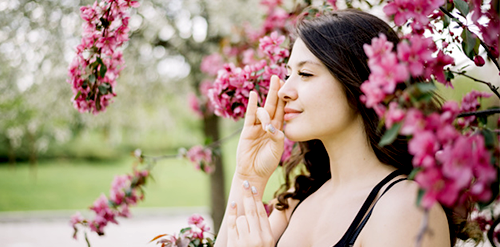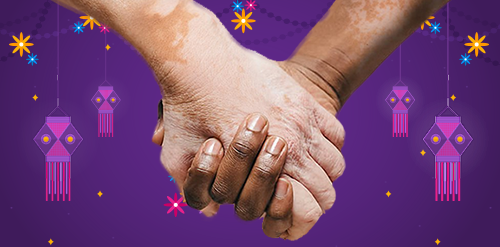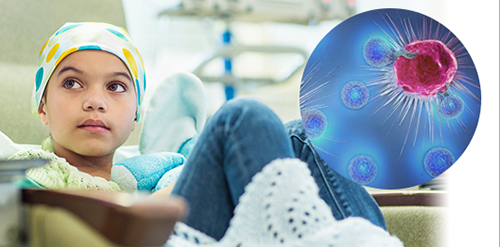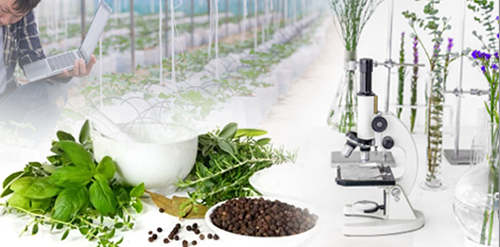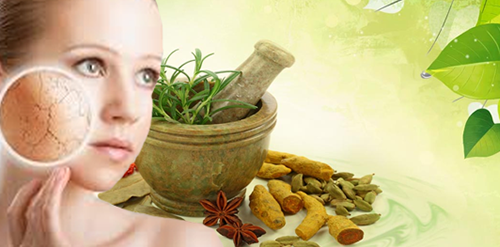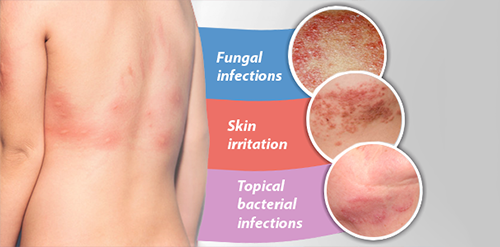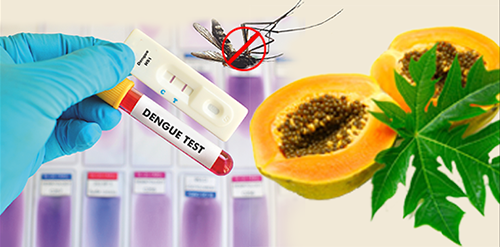Human skin, the outer covering of the body, is the largest organ in the body and constitutes the first line of defense. Skin contains many specialized cells and structures. It is divided into three main layers viz. epidermis, dermis and hypodermis. Each layer provides a distinct role in the overall function of the skin. Epidermis, the outer most layer of the skin, varies in thickness in different regions of the body. The dermis also varies in thickness depending on the location of the skin. It is attached to an underlying hypodermis or subcutaneous connective tissue. The hypodermis or subcutaneous tissue is a layer of fat and connective tissue that houses larger blood vessels and nerves. This layer is important in the regulation of temperature of the skin itself and the body. The size of this layer varies throughout the body and from person-to-person. Hair follicles, sweat glands and sebaceous glands are the main skin appendages. Because it interfaces with the environment, skin plays a key role in protecting the body against pathogens and excessive water loss. Also the skin guards the underlying muscles, bones, ligaments and internal organs. Its other functions are insulation, temperature regulation, sensation, storage and synthesis of vitamin D and the protection of vitamin B folates, absorption of oxygen and drugs and water resistance.
COMMON SKIN PROBLEMS
Skin disease is a common ailment and it affects all ages from the neonate to the elderly and cause harm in number of ways. There are more than a thousand conditions that may affect the skin but most skin diseases can be categorized like:
Rashes: is an area of red, inflamed skin or a group of individual spots. These can be caused by irritation, allergy, infection, an underlying disease, as well as by structural defects for example, blocked pores or malfunctioning oil glands. Examples of rashes include acne, dermatitis, eczema, hives, pityriasis rosea and psoriasis.
Viral infections: These occur when a virus penetrates the stratum corneum and infects the inner layers of the skin. Examples of viral skin infections include herpes simplex, shingles (herpes zoster) and warts. Some systemic viral infections, such as chicken pox and measles, may also affect the skin.
Bacterial infections: Such infections are caused by a variety of bacteria, the most common types being staphylococci and streptococci. Bacteria may infect the topmost layers of skin, the follicles, or the deeper layers of skin. If not treated correctly, these infections may spread throughout the body. Examples include impel folliculitis, cellulitis and lyme disease.
Fungal infections : Harmless fungi are always present on surface of the skin. Infection occurs when these organisms enter into the body. These infections are usually superficial, affecting the skin, hair, nails and include athlete's foot, lock itch and ringworm. However, in people with suppressed immune system or who have been taking antibiotics for long period -, the fungi may spread to deep within the body, causing more serious disease.
Parasitic infections :These infections occur after exposure to parasites such as lice and scabies.
Pigmentation disorders: The amount of pigment in the skin is determined by the amount of melanin being produced by the body. Loss of pigment (hypo pigmentation) can be caused by absence of melanocytes, malfunctioning cells, exposure to cold or chemicals, or some types of infection. An increase in pigment (hyperpigmentation) may be caused by skin irritation, hormonal changes, aging, a metabolic disorder, or any other underlying problem. Age spots, freckles and melasma are examples of hyper pigmentation. Vitiligo is an example of hypo pigmentation.
Tumors and cancers: These growths arise when skin cells begin to multiply faster than normal. However, every skin growth is not cancerous. Some tumors are harmless and will not spread. Skin cancer is caused, in 90% of cases, by sun exposure. The three types of skin cancers are basal cell cancer (the most curable), squamous cell cancer (which may grow and spread) and malignant melanoma (the most deadly form). Prevention involves protecting the skin against damaging ultraviolet rays. Early detection helps to improve the chances of a cure. Regular self-examinations are, therefore, recommended.
Trauma : is an injury to the skin caused by a blow, a cut, or a burn. Whenever the surface of the skin is broken, the body becomes more susceptible to infection and disease.
Other conditions: Wrinkles, rosacea, spider veins and varicose veins are among those conditions that cannot be neatly categorized. Wrinkles are caused by a breakdown of the collagen and elastin within the dermis, which results in sagging skin. Rosacea is a chronic disorder in which the skin of the face becomes red and develops pimples, lesions and more rarely enlargement of the nose. Its cause is unknown. Spider veins and varicose veins become apparent when blood vessels enlarge and become visible through the surface of the skin.
HERBAL DRUGS FOR SKIN DISEASES
Natural drugs from the plants are gaining popularity because of several advantages such as often having fewer side-effects, better patient tolerance, being relatively less expensive and acceptable due to a long history of use. Besides herbal medicines provide rational means for the treatment of many diseases that are obstinate and incurable in other systems of medicine. For these reasons several plants have been used for treatment of skin diseases ranging from itching to skin cancer. Some most important of them are mentioned below.
Ammi majus L. (Aatrilal): Aatrilal is a very effective medicinal plant with a long history of herbal use going back to at least 2,000BC in Egypt, where it was used as a treatment for vitiligo. In traditional medicines seeds of Aatrilal are being used as an emmenagogue to regulate menstruation, as a diuretic, and for treatment of kidney stones and urinary tract infections, and also in skin disorders such as leprosy, psoriasis and vitiligo. The seed contains furanocoumarins (including bergapten and xanthotoxin), which stimulate pigment production in skin that is exposed to bright sunlight.
Psoralea corylifolia L. (Babchi): Babchi seeds have been used since centuries in leukoderma, psoriasis, vitiligo, asthma, ulcers, kidney disorders, and as an aphrodisiac and an anti-inflammatory. It has been reported to yield significant positive outcomes in vitiligo management. Seeds are anti-ageing and help to rejuvenate skin. Seeds has been reported to contain several Phytoconstituents including coumarins and flavone components such as psoralen, isopsoralen, psoralidin, neobavaisoflavone, bavachin, corylin, bavachalcone and possess antibacterial, anti-inflammatory, antifungal, antioxidant, antifilarial, estrogenic, antitumour and immunemodulatory activity.
Achyranthes aspera L. (Apamarga): Apamarga is used traditionally in wound healing, piles, boils, scabies and eruptions of skin and other skin diseases. Recent scientific research showed that leaf extract is valuable antitumor promotors in carcinogenesis, and also showed antibacterial, antifungal and Anti-parasitic activity.
Allium cepa L. ( Piyaj / Onion): Externally; fresh onion juice is used to prevent bacterial and fungal infections. It can be applied to wounds and stings on the skin, used to remove warts, stimulate hair growth, and even reduce unwanted skin blemishes. A study undertaken in patients with seborrheic keratoses to evaluate the ability of onion extract gel to improve the appearance of scars following excision, has shown that this extract gel improved scar softness, redness, texture. In another study results indicated that onion and garlic might be promising in treatment of fungal-associated diseases from important pathogenic genera like Candida, Malassezia and the dermatophytes.
Allium sativum L. (Lahsun/Garlic): Oral administration of garlic is effective on immunologic properties, cutaneous microcirculation, protection against UVB and cancer treatment. Additionally, topical application of garlic extract can potentially be effective on psoriasis, alopecia areata, keloid scar, wound healing, cutaneous corn, viral and fungal infection, leishmaniasis, skin aging and rejuvenation. In a study conducted on Swiss albino mice revealed that best chemo preventive action of garlic was observed in mice in which garlic treatment was performed before and after the induction of skin carcinogenesis.
Aloe vera L. (Ghritkumari /Aloe): Ghritkumari has been one of the most important plants used in traditional medicines for wound healing, to relieve itching and swelling, as well as for its anti-inflammatory properties. Ghritkumari is also used in a variety of skin ailments such as mild cuts, insect stings, bruises, poison ivy, and eczema. It is also found effective in treating wrinkles, stretch marks and pigmentations. It also seems to be able to speed wound healing by improving blood circulation through the area and preventing cell death around a wound. Aloe gel showed antibacterial and antifungal properties and reduced the skin “plaques” associated with psoriasis, helps in the improvement of partial thickness burns and skin survive frostbite injury. Aloe gel also delay the appearance of skin damage during and after radiation treatment.
Azadirachta indica A.Juss. (Neem): Neem preparations are reportedly efficacious against a variety of skin diseases, septic sores, and infected burns. The leaves, applied in the form of poultices or decoctions, are also recommended for boils, ulcers, and eczema. The oil is used for skin diseases such as acne, warts, ringworm, eczema and psoriasis, scrofula, indolent and ulcers. Also the neem preparations are used to heal scars, fights acne, treats pigmentation, a good moisturizer for dry-skin, a gentle exfoliator, as anti-aging agent, and treats scalp infections.
Bauhinia variegate (L.) Benth. (Kachanar): The tribal and non-tribal people of different areas use the plant in several ways for the treatment of skin diseases (leucoderma and leprosy), wounds, ulcers, cough, dysentery, snakebite, tumours, flatulence, indigestion, piles and also lots of other ailments. The bark is internally administered for treating skin diseases, asthma, sore throat, diarrhea and abdominal discomfort and also applied externally for skin ulcers. In the skin papilloma model, significant prevention, with delayed appearance and reduction in the cumulative number of papillomas has been observed in scientific studies.
Calendula officinalis L. (Calendula / Marigold): Calendula used in Traditional system of medicine for treating wounds, ulcers, herpes, scars, skin damage, frost-bite and blood purification. Calendula oil has antifungal, anti-inflammatory, and antibacterial properties that might make it useful in healing wounds, soothing eczema, and relieving diaper rash and also used as an antiseptic and also used to treat acne. One laboratory study found that calendula extract is useful in treating and preventing acne vulgaris. Calendula oil improves the overall appearance of skin. One study found that a cream containing calendula extract promotes skin hydration and firmness.
Camellia sinensis (L.) Kuntze (Chaay/ Green tea): Green tea may play a beneficial role in treatment of skin tumours and cancer. It contains polyphenols, which act as antioxidants in the body. A specific polyphenol in Green tea called epigallocatechin gallate, has been reported fights DNA damage from UV rays to prevent the onset of further growth of skin tumor in the body. It can rejuvenate old skin cells to start reproducing again, keeping the skin younger looking.
Curcuma longa L. (Haldi): Haldi has been described in Ayurvedic medicine for treatment for various respiratory conditions, liver disorders, anorexia, rheumatism, diabetic wounds, runny nose, cough, and sinusitis and commonly used in the treatment of ringworm, obstinate itching, eczema, and other parasitic skin diseases. Haldi is applied to facilitate the process of scabbing in chicken pox and small pox. Topical application of haldi has been useful in external cancerous skin lesions, psoriasis, and wound healing and plays a very key role in both aging and the main age-related chronic degenerative diseases. The main active constituent of Haldi is Curcumin, which possesses antioxidant and anti-inflammatory activity that may provide glow and luster to the skin.
Plumbago zeylanica L. (Chitrak) : Chitrak is very popular throughout India and Asia as a remedy for skin diseases, infections, and intestinal worms. The plant has been found significant in different clinical conditions, especially inflammation, leprosy, scabies, ringworm, dermatitis, ulcers, hemorrhoids, and hookworm. Whole plant is crushed with a pinch of salt and the paste is applied externally in case of ringworm. The main active compound in the plant is plumbagin, which has been shown to possess several pharmacological activities including antimicrobial, antiplasmodial, anticancer and antifertility actions. A study conducted on plumbagin revealed that topical application of plumbagin in mice inhibited UV induced development of squamous cell carcinomas. Plumbagin has shown antibacterial activity against both gram-positive and gram-negative bacteria, whereas it is also active against certain yeasts and fungi and protozoa.
Portulaca oleraceae L. (Kulfa) : The herb possesses natural cooling properties that soothe the skin, relieving it of skin inflammations and rashes during scorching heat. Burns and skin eruptions like boils and carbuncles can be treated with an effective concoction of the leaves. Topical application of the aqueous extract on to the skin is effective as antibacterial and antifungal. Externally it is used to treat burns, earache, insect stings, inflammations, skin sores, ulcers, pruritis (itching skin), eczema and abscesses which are usually treated with the fresh herb as a poultice or the expressed juice is used. Kulfa extract is rich in catecholamines such as L-methyl-adrenalin and dopamine. These substances have anti-allergic property. Kilfa is rich in omega-3 fatty acids, an important anti-inflammatory ingredient for human skin. It has effect of relieving skin inflammation and inhibiting skin itching caused by dryness. Kulfa extract has a good therapeutic effect on purulent skin problems such as acne. Kulfa is abundant in antioxidants such as vitamins A, B1, B2 and vitamin E, C and carotene which prevent skin wrinkles and fine lines. Therefore, Kulfa extract brightens skin tone and reduce skin damage caused by UV, thereby delaying skin aging.
Rosmarinus officinalis (Rusmari): Rusmari is a common household plant grown in many parts of the world. It is used for flavouring food, a beverage drink, as well as in cosmetics. The anti-inflammatory properties of Rusmari extract help to reduce swelling and puffiness of the skin. It also helps to heal burns, soothe skin and remove roughness, dark patches, acne, blemishes, wrinkles, fine lines etc. of the face. This herb's medicinal qualities make it a powerful cure for chronic skin conditions including dermatitis, eczema and psoriasis. The most important constituents of Rusmari are caffeic acid and its derivatives such as rosmarinic acid. These compounds have antioxidant effect. Aqueous extract of Rusmari has been reported to be effective in preventing cutaneous photo damage induced by UV radiations. Rusmari essential oil also showed antibacterial activity against Propionibacterium acnes, responsible to cause acne. Since it contains naturally powerful antioxidants, Rusmari oil strengthens the capillaries and helps to slow the effects of ageing on skin. It also tightens sagging and loose skin to help it look firmer and more elastic. Additionally, Rusmari stimulates biological activity and cell growth to reduce fine lines and wrinkles.
Saraca asoca (Roxb.) De Wilde (Ashoka): Paste of the roots and flowers is useful in freckles and external inflammations, ulcers and skin diseases such as eczema, psoriasis, dermatitis, ulcers, scabies and Tinea pedis. A study revealed that pre-treatment with the flavanoid fraction of Ashoka caused significant reduction in the number of tumors. Furthermore Ashoka is used to revitalize the complexion and skin tone. Methanolic extracts of Ashoka bark, leaf and seed showed inhibitory effects on tyrosinase production thus Ashoka promote the beauty and health of skin.
Thymus vulgaris L. (Thyme): Given its antibacterial and antifungal properties, thyme oil can protect skin from related infections. The oil also heals acne, sores, wounds, scars, and cuts. It even relieves burns and acts as a natural remedy for skin rashes. It may relieve the symptoms of cellulitis, an infection of the skin caused by bacteria which can lead to pain, tenderness, edema, fever, chills and reddening of the skin. Its active constituent, thymol, is active against Enterobacteria and Cocci bacteria. It is used for skin issues like oily skin, sciatica, acne, dermatitis, skin condition and bug bites.
Zingiber officinale Roscoe (Adarak): In addition to its medicinal value, Adarak has been used in skin care as well. It is often used in a number of commercial products to improve the skin. Ginger juice is often applied topically to treat several skin issues such as Anti-Aging Benefits, Soothes Burns, Clears Blemishes and Acne, Treat Hypo pigmented Scars, and Tones Skin.
Withania somnifera Dunal (Ashwagandha): Ashwagandha, which is abundant in antioxidant, immune boosting, anti-inflammatory, sleep inducing, anticonvulsant, anti-stress, and antibacterial properties, is like the one-stop shop for all ailments. It was found to be effective in prevention of skin carcinoma in UVB radiation-exposed animals, DMBA-induced carcinogenesis and in long-term tumorigenesis. The antioxidants properties of Ashwaandha successfully fight the damaging free radicals produced via exposure to harmful UV radiation from the sun, treat dark spots, wrinkles, and fine lines and reap its anti-aging benefits, Promotes Wound Healing, Treats Keratosis, Decreases Cortisol Levels, Stimulates the Production of Collagen, used as a Skin Toner, and soothes Skin Inflammation.




